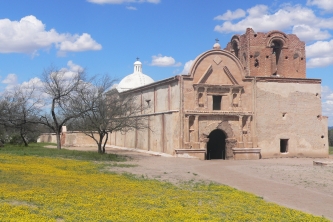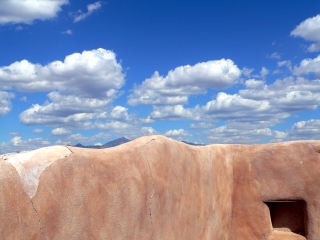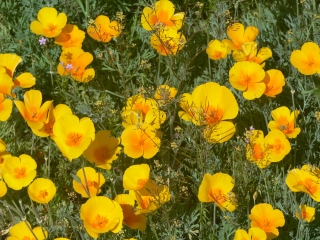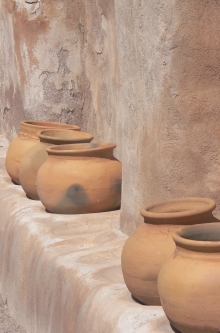NPS Website; Local Website
 WHAT IS IT?
WHAT IS IT?Ruins of a Jesuit mission established in 1691, rebuilt in 1751 and abandoned in 1848; its unsuccessful purpose was to convert the native Pima Indians to Catholicism in order to make them good citizens of the Spanish colonial empire.
BEAUTY (8/10)
It could have been anything; the big crystal blue sky, the field of yellow wildflowers, the perfect 80º day, the impatient vermillion flycatchers or even the rippling adobe lines of the mission ruins. But everyone touring the Site was reduced to blubbering aloud, “oh my gosh, what a gorgeous day. This place is so beautiful.” We were not immune.
HISTORICAL INTEREST (5/10)
17th Century Spain had a problem. They wanted to colonize their claims in the New World but did not have enough of a population base to send large amounts of settlers. Their solution was to send priests who would convert the natives into loyal Christian Spanish subjects. The same pattern of colonization occurred around the areas of San Antonio, Texas, Santa Fe, N.M., El Paso, Texas and Tucson, Ariz. Later, even sparser populated missions sprouted up the coast of California.
Jesuit Eusebio Kino established the missions near Tucson, which included Tumacácori. Unlike the successful colonization that happened in San Antonio, the local Pima Indians did not convert easily. A 1751 Pima revolt saw the deaths of two priests and hundreds of settlers as well as the destruction of a few missions. As a result, Tumacácori was rebuilt at its present-day location and a military presidio was established nearby.
The mission at Tumacácori was bound to fail. There were constant fights with warring Apaches, scattered diseases, Jesuit expulsion from New Spain in 1767, lack of colonial support and a general Pima desire to hold onto their religious ways. The mission was finally abandoned when the 1848 Mexican-American War began.
 CROWDS (8/10)
CROWDS (8/10)We expected to be touring the mission alone. Instead at least 100 people visited the grounds along side of us. The number might seem like a lot in such a small place, but everyone was so happy and awed by the beautiful day. We could not help getting caught up in the infectious happy spirit. Yes, we were blissful while touring an 18th Century Jesuit mission.
EASE OF USE/ACCESS (3/5)
Tumacácori NHP is 58 miles south of Tucson, Ariz. straight down Interstate 19. The Park’s exit is Exit 29. 18 miles south of the Site, still along Interstate 19, is the large Mexican border town, Nogales. Be aware that south from Tucson, I-19’s signs and exit numbers are all measured in kilometers. Is this the only interstate in the U.S. that uses the metric system?
CONCESSIONS/BOOKSTORE (5/5)
A terrific selection of books that includes sections dedicated to the Tohono O’odham, Yaqui, and Apache Indians. Reprints of original Spanish colonial journals and diaries allow the casual tourist to descend into some hardcore primary document learning. There are mission history, architecture and coffee table books.
We especially liked the good selection of books regarding the U.S.-Mexico border, its lifestyle, culture and problems from a distinctively Arizonan perspective. These titles are all but ignored at Arizona’s other two border parks, Organ Pipe Cactus NM and Coronado NMEM. In contrast, many of the Texas park site bookstores (LBJ NHP, Chamizal NMEM, Amistad NRA, Big Bend NP and Palo Alto NB) address Mexican relations. Perhaps there is something about Texas history that makes its people more open to thoughtful borderland discussions.
The bookstore also sells tiles emblazoned with pictures of the mission, Pima baskets, T-shirts and lots of cool magnets. Tumacácori is a one-stop shop for all your southwestern U.S. Jesuit mission needs.
COSTS (3/5)
The Site costs $3 per adult but is free with the National Parks Pass.
RANGER/GUIDE TO TOURIST RATIO (2/5)
Every now and then, a Ranger wandered into the bookstore. We managed to have a few questions answered about the 1767-68 Jesuit expulsion from New Spain.
 TOURS/CLASSES (6/10)
TOURS/CLASSES (6/10)We were told that there are no longer Ranger-led tours of Tumacácori NHP. Instead, visitors utilize a thick self-guided trail brochure. Our concentration tended to lapse with the brochure because it was such a glorious day.
We enjoyed the aging video and museum a great deal. The video has almost no explanations and no narrative voiceovers. Instead, it shows everyday life at the mission, including a three-minute scene of Indian children speaking in their native language and playing a stick rolling game. Another long scene consists of a priest teaching the same children about Jesus Christ – in Spanish.
The video was slow moving but so realistic and understated that it was confusingly abstract. The viewer had to figure out what was going on in the picture. It was as if a time machine had dropped you off in this odd era of human existence. Once we got used to the video, we loved it.
The museum is noted by its many fearfully gruesome images: a cloth depicting a presumably unconverted Indian burning in hell and a life-sized mannequin sitting in a chair, back turned, adorned in a Jesuit’s black robe. OK, maybe the Jesuit mannequin should not be scary, but that did not stop us from shrieking and actively avoiding that part of the museum.
FUN (6/10)
We had a great day. It’s hard not to when the weather is so wonderful and everyone around you is as surprised as you are at the beauty of a place. Jesuit missions, in general, are not fun places. Statues and imagery are graphic in detail. Hellfire and brimstone are the incentives. Is it any wonder the Pima had no interest in converting to what seems like a very punitive and demanding monotheism?
To be honest, the tour of the mission ruin took the least of our time. We spent most of the afternoon trying to capture the blues of the sky at every photographic angle, discussing the movie and chasing a vermillion flycatcher from tree to tree.
In retrospect, we wished we would have added a stop at the mission’s presidio in Tubac on the way back to Tucson. That may have given us a more complete picture of Spanish attempts to convert and control 17th century southwest.
Instead, we drove north to the Madera Canyon portion of Coronado National Forest and got the last campsite available. Phew. There we saw a few species of hummingbirds and the rare Arizona woodpecker. We made the right choice skipping the Tubac presidio.
 WOULD WE RECOMMEND? (6/10)
WOULD WE RECOMMEND? (6/10)If you are spending time in Tucson, a combination visit of Tumacácori NHP and the San Xavier del Bac mission (about 20 miles south of Tucson, also off I-19) makes for a nice day trip. They were both established in the late 17th Century by Jesuit Eusebio Kino for the same purpose, expanding Spain’s influence in the New World and/or converting the supposed pagan Indian souls.
However, San Xavier del Bac was completed in 1797 remains active. The church has a gorgeous baroque façade and is shortlisted as a possible UNESCO World Heritage Site. The finished, active and bustling San Xavier del Bac mission, complete with school girls selling candy bars outside, serves as a fascinating contrast to the ruins of Tumacácori.
TOTAL 51/80
www.usa-c2c.com
© 2004-06